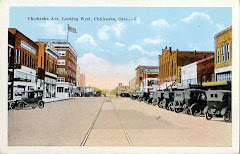From Whistle Stop to First Class City
Located on rolling Oklahoma prairie land, the town site was once inhabited by Indian tribes and buffalo herds. Called “No-Man’s Land” in the 19th Century, the area abounds with ancient Indian artifacts and trails which mark the presence of early man. The name “Chickasha” presumably comes from an Indian word meaning “rebel, and Grady County was named for the famous Southern orator, Henry W. Grady.A treaty known as “Doak’s Stand” signed at Dancing Rabbit Creek, first included Grady County in land given to the Chickasaw Nation in 1821. Before there was a town, the site of Chickasha was included in the “Swing Ring” cattle ranch owned by an intermarried citizen of the Chickasaw Indian Nation. Until Statehood in 1907, the area was divided into Oklahoma Territory and Indian Territory.
It all began with a small shack town in 1892 when the Rock Island Railroad stopped its tracks for several months. Arrival of the St. Louis and San Francisco Railroad about ten years later, the Oklahoma Central – later the Santa Fe Railroad – in 1907, and the subsequent highway development that followed in later years ensured Chickasha’s future as a regional market hub.
When the Rock Island made Chickasha a whistle stop, the existing town site was purchased from the Indian family and a flourishing tent camp sprang up in the middle of a cornfield. Plenty of land meant a new life for many. Merchants, doctors, lawyers, and bankers were quickly attracted to the area. In 1902, ten years after its founding, Chickasha had a population of 6,370 and became a first class city. Its growth was greatly stimulated by the opening to white settlement in 1901 of the Kiowa-Comanche reservation, which adjoined the former Chickasaw Nation on the west. 
Early day Chickasha businessmen formed an organization to work together in the interests of the community. Called the “Chickasha Commercial Club,” it later evolved into the Chickasha Chamber of Commerce. In 1971, Chickasha was designated an “All-American City” by the National Civic League for its continuing efforts to secure and expand industrial, educational and social programs.
Dubbed “Queen of the Washita Valley,” Chickasha is now included in the Oklahoma City MSA, and remains a prosperous city with a healthy, diversified economic base. Our schools continue to press forward with new building construction and innovative educational outreach. Our Economic Development and Chick, Inc. organizations are actively pursuant of new industry and business opportunities. Our business and city leaders are actively working together to unite and beautify our city. Chickasha is a great place to live. We welcome you to come join us.






No comments:
Post a Comment